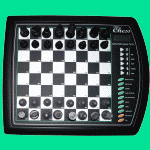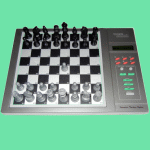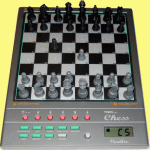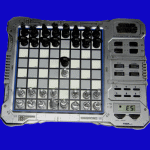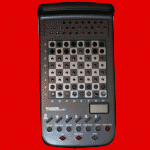Tiger Electronics is an American toy manufacturer, best known for its handheld LCD games, the Furby, and Giga Pets.
Randy Rissman and Roger Shiffman founded the company in 1978. It started with low-tech items like phonographs, but then began developing handheld electronic games and teaching toys. It achieved success with many simple handheld electronics games like "Electronic Bowling" and other titles based on licenses, such as "Robocop", "Terminator", and "Spider-Man". An early 90's hit was the variable speed portable cassette/microphone combo Talkboy (seen in the 1992 movie Home Alone 2), followed by the Brain Warp. It also licensed the "Lazer Tag" brand from its inventors, Shoot the Moon Productions, which was born from the remnants of the Worlds of Wonder company. Tiger also produced a version of Lights Out around 1995. In 1997 it also produced a quaint fishing game called Fishing Championship, in the shape of a reduced fishing rod.
Tiger has made two cartridge based systems. The first and less technically sophisticated was known as the R-Zone. It employed red LCD cartridges, which were projected via backlight onto a reflective screen that covered one of the player's eyes. All R-Zone games were adapted from existing Tiger handheld LCDs. The second was the game.com handheld system, which was meant to compete with Nintendo's Game Boy and boasted such novel features as a touchscreen and limited Internet connectivity. Ultimately, it was a failure, with only 20 games produced.
Tiger Electronics has been part of the Hasbro toy company since 1998. Hasbro, previously shy of high-tech toys, was very interested in the development of the cuddly "Furby". With Hasbro's support, Tiger was able to rush through the development process and get the Furby on the shelves for the 1998 holiday season, during which it was a runaway hit -- the "it" toy of the 1998 and 1999 seasons.
Tiger also created the Giga Pets line of handheld electronic pets to compete with the popular Japanese Tamagotchi.
The company has since become one of the most prominent producers of electronic toys, chosen to produce toys based on a wide variety of licenses, including Star Trek, Star Wars, Barney, Arthur, Winnie the Pooh, Franklin the Turtle, Neopets, Wheel of Fortune, Jeopardy!, Who Wants to Be a Millionaire? and many more.
In 2000, Tiger was licensed to provide a variety of electronics with the Yahoo! brand name, including digital cameras, webcams, and a "Hits Downloader" that made music from the Internet (mp3s, etc.) accessible through Tiger's assorted "Hit Clips" players. Tiger also produces the VideoNow personal video player, the VCamNow digital camcorder, and the ChatNow line of kid-oriented two-way radios.
The continuing development of Furby-type technology has led to the release of the "FurReal" line of toys in 2003.
Above excerpts taken from The Free Dictionary
It seems that Tiger Electronic sold chess computers sometime between 1992 and when they were taken over by Hasbro in 1998. Not dissimilar to Milton Bradley, Hasbro then of course stopped the sales of electronic chess computers a short time later.
All the electronic chess computers sold by Tiger Electronics either originated from CXG or Excalibur Electronics which in either case means the same Hong Kong/China connection.
HASBRO, INC. AND TIGER SUBSIDIARIES
- Tiger Electronics UK Limited United Kingdom
- Tiger Electronics Far East, Limited Hong Kong
- Tiger Electronics Far East Services, Limited Hong Kong
Another interesting article which helps to explain the reasons of why Hasbro bought Tiger Electronics is this excerpt taken from Wired
Moody Furballs And The Developers Who Love Them
- It smiles.
- It sneezes.
- It sings.
- It never shuts up.
- It's the toy that will make you forgive Barney.
By Scott Kirsner
Alan Hassenfeld was in the showroom. And Furby was dead.
The chair of Hasbro, the world's second-largest toy company, had arrived at Tiger Electronics's New York showroom on the 13th floor of the Toy Building, 200 Fifth Avenue. It was Friday, February 6, 1998. Hasbro had been searching for a tech-savvy acquisition to give it an edge over arch rival Mattel. Hassenfeld believed Tiger, a specialist in electronic gadgetry and, with its Giga Pets line, a big player in last year's virtual-pets fad, was that company. Three days later, he planned to announce Hasbro's US$335 million purchase of Tiger.
But three rooms away, Tiger's top product developers and engineers were scrambling to resuscitate their secret weapon: Furby. The toy worked fine in Tiger's backstage workshop, yet when the rotund little creature was brought into the showroom and switched on - nothing. An animatronic "plush" animal that children could nurture and teach and play with, Furby was intended to be a sort of Giga Pets 2.0 - Tiger's follow-up to last December's top-grossing toy. But the 5-inch hairball with the gremlin ears and saucer eyes was lying motionless on its display table.
Hassenfeld, accompanied by Tiger's proud cofounders, began winding his way through the circuitous showroom, surveying his new domain. It was about this time that Jeff Jones, Tiger's vice president of marketing, began to sweat. He'd devoted the past three months of his life to bringing Furby this far. He looked up at the hot halogen lights in the showroom and asked his engineers if maybe the temperature was too high for Furby. Jones was close. The lights were creating an electromagnetic field that was interfering with the signals traveling along a wire between Furby and a concealed black emulator box, which contained all of the toy's electronic guts. Frantically, Jones and his colleagues took some tin foil and wrapped it around the cord, to shield it from the radiation.
Hassenfeld stopped in front of Furby. "This is your bonus for buying Tiger," proclaimed Tiger chair and cofounder Randy Rissman. With no idea whether Furby would work, Jones flipped the switch. Furby performed on cue, opening its eyes and chattering with delight for the Hasbro chair. Though this prototype contained just 5 percent of the functionality that the final toy would have, Hassenfeld told Tiger's cofounders that Furby was the coolest thing he'd seen in his 25 years in the business.
The next week, Furby would début at the 95th American International Toy Fair; if all went according to plan, it would be the big toy for Christmas. Yet by all rights, the toy shouldn't have gotten this far: Tiger had rushed it into development only three months earlier, astonishingly late by industry norms. But Tiger was desperate for a hit. It needed an encore to Giga Pets. And Hasbro, which had watched Microsoft enter the toy business with its Interactive Barney doll and stood by as Mattel formed a joint venture with Intel, was anxious to stake out its position as a purveyor of technologically sophisticated playthings.
They both needed Furby.
American toy companies have long been skittish about technology. In the 1980s, the videogame business bankrupted Coleco, the maker of Cabbage Patch Kids and ColecoVision, and nearly brought Mattel to its knees. Early in the 1990s, Hasbro funneled a reported $45 million into a virtual reality project before abandoning it. Hasbro execs understood how to manufacture and market action figures like G.I. Joe, but when it came to chips and code, they were clueless.
Which was a problem. The recent success of toys containing microprocessors, from Tickle Me Elmo to Tamagotchi to Barney, has buttressed the belief that technology will be the industry's savior. While earlier generations of high tech toys were clunky and unresponsive to a child's input, the newer ones insinuate themselves into their owner's life in sometimes alarming ways. Some schools banned virtual pets because children were more focused on "feeding" them than on paying attention to the teacher, and many parents fretted when their offspring began mourning digital creatures that had croaked. Toys like Furby, which exhibit rudimentary artificial intelligence, integrate themselves even more tightly with a child's life - speaking a secret language, playing games, seeking praise. The technology is increasingly invisible; no instruction manual is necessary, and children can have what they most desire: the perfect friend, loyal and unconditionally loving.
The above article explains quite well the reason why Hasbro was interested in buying Tiger Electronics, which for dedicated chess computer fans unfortunately resulted in the speedy end of yet another supplier of electronic chess computers.
11-004 - 1998
Chess Marathon Deluxe

Table Top
1997
Chess Protege

Travel
11-005-02 - 1997
Grand Master
Table Top
11-006 - 1998
Grenadier
Table Top
11-010 - 1997
Chess Marathon
Table Top
88-506 - 1999
Star Wars Episode 1
Table Top
11-009A - 1997
Trekker
Travel
11-007 - 1998
Voice Master
Table Top
11-008 - 1997
Protege
Table Top
11-002 1997
Crusader Pocket Chess

Travel

